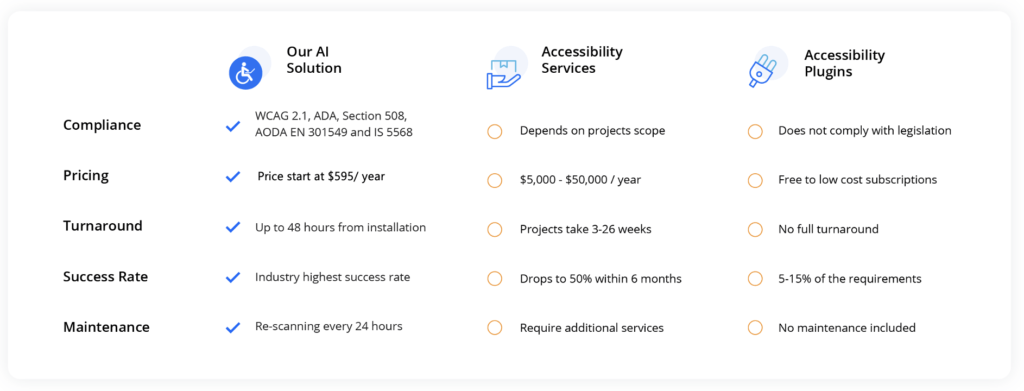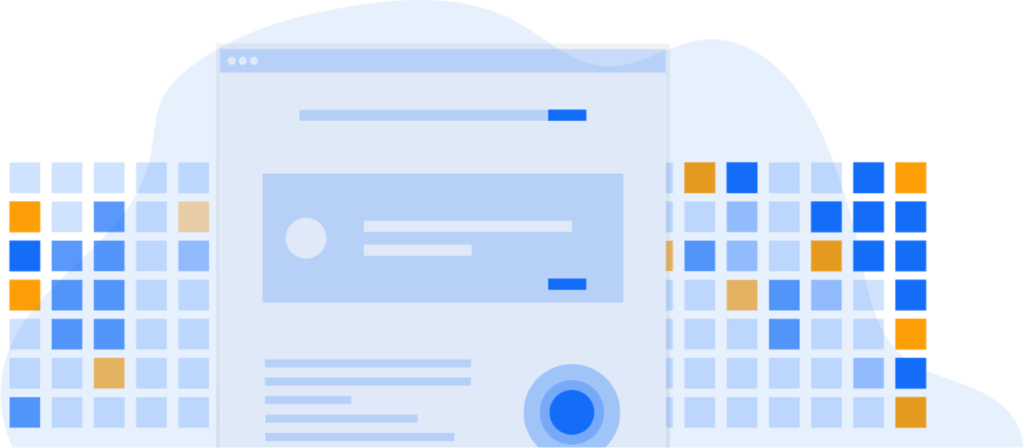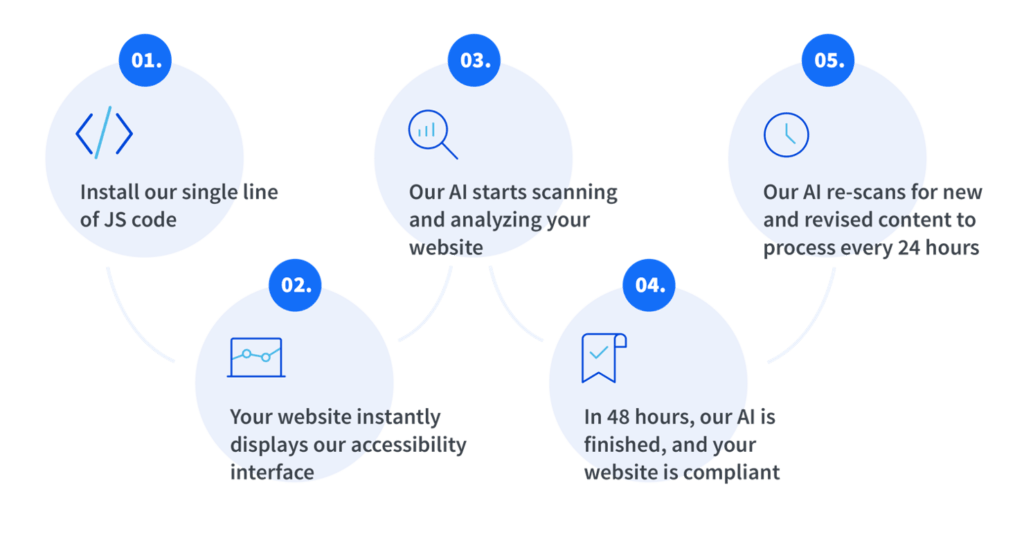
About Web Accessibility

Web accessibility is practically a set of rules, behaviors, code standards, and design guidelines that were created by the W3C and are called the WCAG 2.1.
The WCAG 2.1 is basically a 1,000-page guidebook explaining what accessible websites look and operate like to people with disabilities, who by the way comprise 20% of the population.
There are many disabilities covered, namely:
- blind people using screen-readers,
- the motor-impaired using only the keyboard to navigate,
- epilepsy, color blindness,
- cognitive and learning disabilities,
- visual impairments, and more.
The WCAG 2.1 at the AA level has been adopted by governments around the world in legislation such as the ADA title 3, Section 508, AODA, EN 301549, and many others.
About the Legislation
ADA compliance lawsuits are on nothing short of an intense rise. 200% year over year, with reports of 100’s of thousands of demand letters and lawsuits, targeting businesses of all sizes from enterprises to SMB’s and Mom & Pop shops. Many do not think for a second that it will ever happen to them, but unfortunately that is not the case at all. With a quick google search you will find thousands of articles surrounding this situation touching upon every vertical and industry.
When did this happen? This trend began to skyrocket in late 2018 right after the DOJ officially affirmed that websites are considered public accommodations and therefore must comply with Title 3 of the ADA.
I’d like to point out that 2019 has already tripled 2018 in the number of papers served. This means that for every business hour in 2019, there were papers served. You will also find that in almost every situation, the plaintiff wins the case on its merits because it’s a strict liability law and judges are often understandably sympathetic to people with disabilities who really only want equal rights. There is virtually no chance of winning an ADA case when you’re not compliant. The lawyers simply advise their clients to write a check since there is no point in fighting it.
A quick example of what’s going on as well: A visually impaired woman from Broward County, Florida sued 175 business owners several of which closed down as a result.
Now in the 2020 Covid era, we’re seeing those in quarantine have less access to physical locations and amenities, and they are finding more difficulty in accessing the web for essential services.
The Market
Alright, let’s pivot a bit and discuss a few words about the market. The current alternatives are either plugins that don’t provide ADA compliance at all; or manual services that do, but cost about $15K to start, take several weeks to implement, and require tedious and costly maintenance.
Those options, as you can imagine, leave 99% of businesses without a feasible solution, making them:
- Easy targets for lawsuits, and
- Preventing them from helping people with disabilities.
Bottom line, business owners want to make their websites accessible and avoid lawsuits, but they just can’t. To solve this impossible situation, we created the Ai accessibility tool.
Artificial Intelligence
The accessibility tool is an AI-powered machine-learning software that was developed with the understanding that this problem needs a solution that is simple, immediate, affordable, and of course, achieves compliance worldwide.
The only way to achieve full compliance and without the need for manual remediation, is by utilizing AI. The solution makes the entire process automated, and therefore we are able to cut costs and achieve a win-win situation for businesses and for people with disabilities, who simply want equal access to the internet.
Accessibility Statement
This document on the right is the accessibility statement and it basically explains all the adjustments the solution does to the website, browser and assistive technology compatibility and describes how to report issues if found within the interface. Having the accessibility statement is a compliance requirement as well.
The statement is also available to all users within the interface and will be sent to you via email, 48 hours from the installation once the AI completes its process.
[NEXT SLIDE]
Our Process
This Segways into our process, by far the best part of becoming compliant with us is definitely the super simple process, which in my opinion makes all the difference:
- [Installation] First, we install our single line of JavaScript code which takes 5 minutes to install and can integrate with any website or CMS platform.
- [Interface] Then, your website instantly displays our accessibility interface (see ours on this webpage, click the orange accessibility icon lower left).
- [AI Process] simultaneously, the AI kicks in, and in up to 48 hours, it is finished, and the website is accessible and compliant. This is also when you receive the accessibility statement to your email.
- [Maintenance] and our biggest advantage is the automatic maintenance. The AI re-scans the website every 24 hours, making sure that any changes or additions are also being remediated.
Ultimately, after the 5-minute installation, you can forget about compliance issues; everything else is done automatically, even for websites that update daily.
How We Achieve Compliance
Our solution achieves compliance by leveraging two components.
The first is our accessibility interface that is responsible for handling the UI, design and cognitive-related adjustments. This interface is also fully customizable and can adapt to your website’s design easily with options to choose the colors, icons, positions, and shapes right from your website in just a few clicks.
The second is the AI, machine learning-powered process, that handles keyboard navigation adjustments for the motor-impaired and blind people’s screen-readers.
A screen-reader is a software used by blind people to operate computers and websites and it’s installed on the operating system. It basically reads aloud the content focused on the screen, and it also helps with navigation and orientation aspects. Adjustments to those screen-readers are what the legislation requires.
Our solution handles all on-site aspects using a “Contextual Understanding” AI technology that is responsible for remediating menus, drop-downs, pop-ups, forms, icons, buttons, and all other elements by applying the appropriate screen-reader text and website behaviors.
To automatically provide accurate alternative texts for images, also known as alt tags, our solution utilizes IRIS and OCR technologies to scan and learn the objects as well as the text that is embedded within the image.







